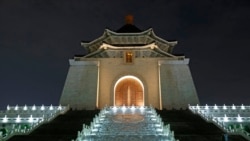A cabinet-level commission in Taiwan has proposed removing a giant statue of its former president Chiang Kai-shek — the centerpiece of a memorial hall in Taipei dedicated to the military leader, who served as the island’s president from 1949 until his death in 1975.
But the proposal, part of the commission’s larger plan to convert the memorial into a reflection on Taiwan’s authoritarian past, has drawn mixed reactions.
Chiang’s legacy
Chen Yu-fan, a commissioner at Taiwan’s cabinet-level Transitional Justice Commission, said that her commission views the removal of the statue as an effort to erase Chiang’s legacy and lose opportunities to learn from the country’s history. Taiwan has evolved from a dictatorship into one of Asia’s most vibrant democracies over seven decades, Chen told VOA.
Chiang’s supporters view him as a strong leader who led Taiwan to fend off the invasion of the Communist forces and initiated land reforms in Taiwan during his rule.
Critics, however, disagree. They point out that Chiang was accused of ordering the execution of more than 18,000 civilians in 1947 during what is known as the island’s period of “white terror.” The commission was established in 2018 to redress the wrongs of the island’s authoritarian era. It aims to submit its transformation plan, including the statue’s removal, to the cabinet for approval in May next year, according to Chen.
“Chiang was recognized as an authoritarian leader, who built a one-party state and committed many human rights abuses including his act of judicial interventions to have political dissidents persecuted,” Chen said.
“We don’t think the government should continue to devote national resources on such a large scale to worshiping such an autocrat — a move unheard of in any of modern democracies,” she added.
The 6.3-meter-tall bronze statue is the island’s largest symbol of authoritarianism, according to the commission.
Compared to the Taliban
But the Chinese Nationalist Party, an opposition party commonly known as Kuomintang (KMT), rejected the initiative saying it would be destroying cultural heritage. The plan to remove the statue, they said, is similar to the time when the Taliban blew up Afghanistan’s giant Bamiyan Buddhas statues in 2001.
Angel Hung, a KMT spokesperson, said the proposal drives a wedge between members of Taiwanese society.
“Removing the statue simply will not bring about reconciliation. And preserving the statue actually does not imply recognition of the past,” Hung told VOA. “So, dividing the society again is what the removal would represent.”
Chiang was seen by many KMT supporters as a strong leader who led when Taiwan was defending itself against the invasion of the Communists. After losing a civil war to the Communists in mainland China in 1949, Chiang led his troops to Taiwan and set up a rival government where he imposed decades of martial law.
'Mockery of democracy'
Chilly Chen, the chairman of Taiwan Republic, a pro-independence group in Taiwan, however, dismissed the KMT’s glorification of Chiang. He said Chiang was responsible for atrocities.
“Chiang Kai-shek was a murderer. He was a killer. He also was a butcher,” Chen said describing the military leader. “Tens of thousands of people [were] killed by him including Chinese and Taiwanese. And this huge statue here makes [a] mockery of the democracy of Taiwan, which claims to honor freedoms, human rights and rule of law.”
In the past few years, Chen had thrown eggs at Chiang’s statue several times or splattered paint on the statues to express the group’s view.
Chen isn’t alone in demanding the removal of the statue. Families of more than 18,000 victims of a 1947 massacre led by Chiang view the statue as a painful reminder.
“Some victims remain alive, but they are very old. I hope they will live to see that our society is finally willing to redress the injustice. Let’s not wait before it’s too late so that they will pass away with regrets,” Yvon Lin, a Taipei city council member, told Reuters.
Loss of tourism
Despite growing calls for transitional justice, the general public in Taiwan appears indifferent to the commission’s transformation proposal.
Others worry that the statue’s removal may mean a loss of tourism revenue. An online survey by a local news outlet further found a high disapproval rate at 92%.
“To me, this is not a symbol of authoritarianism. I see him [Chiang Kai-shek] as the first leader who brought the [Chinese] culture over. It isn’t about worshiping the authority, but our collective memory,” Mr. Liu, a visitor to the memorial, told VOA.
“I think [tourism] will be negatively impacted. Many tourists have come here to see the statue,” Ms. Chang, another memorial visitor, also told VOA.
'Right thing to do'
But some historians say the removal will show how firmly democratic values have become entrenched in Taiwan.
Taiwan’s move parallels the removal of authoritarian symbols in modern democracies including the Confederate statues in the United States, said Lee Hsiao-feng, an honorary professor at National Taipei University of Education in Taipei.
“This is absolutely the right thing to do. But I suggest not to abandon the statue. Move it to Chiang’s statue park in Cihu (near his mausoleum in Taoyuan, norther Taiwan) because this statue is a piece of historical evidence that bears witness to the era of a dictator,” Lee told VOA over the phone.
More than 200 statues of Chiang have been relocated to this Cihu lakeside park, which has become a major tourist draw especially for visitors from China.
But official statistics show that there remain more than 1,100 Chiang statues in public places around Taiwan.





